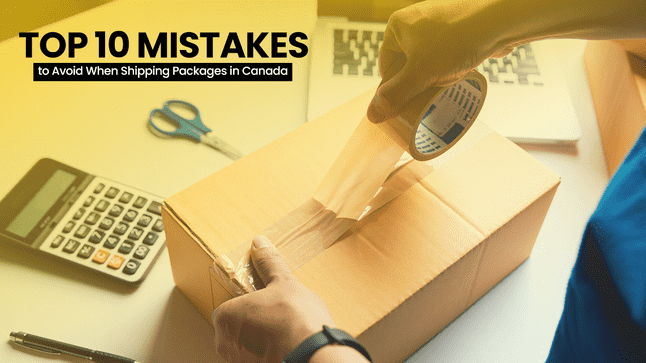Ever thought about how giant shipments travel across the country without delay? Or, how is the whole truck packed with goods and delivered quickly? Welcome to Full Truckload (FTL) shipping!
This method is created to transport large freight with maximum efficiency and security. But how does it work, and why is it considered the best choice for businesses?
Whether you are a business owner wanting to streamline your supply chain or just want to know about the world of logistics, understanding FTL shipping will give you a look into how goods move faster and more efficiently than you might expect!
In this blog, we will learn what FTL shipping is, how it works in Canada, its benefits over other freight options like LTL shipping in Canada, and how to choose the right shipping method for your needs.
What Is FTL Shipping?
FTL shipping, or full truckload shipping, refers to the transportation of items that fill the whole truck. Instead of sharing truck space with other businesses (as in LTL- Less than truckload), FTL transport is used when a shipper needs the full space of the truck. This method is best for large shipments, sensitive goods, or when time efficiency is important.
For example, a furniture retailer that transports a full load of sofas and beds from Toronto to Vancouver would benefit from FTL shipping since it does not require any unnecessary stops or transferring of the shipment along the way.
How FTL Shipping Works in Canada
In Canada, FTL in transportation consists of a large, fully developed infrastructure of highways and logistics hubs. While the process can vary somewhat in detail, it usually goes like this:
- Booking A Load: The shipper books a fully assigned truckload, moving through a carrier or logistics company.
- Loading: The goods are loaded onto the truck at the shipper’s location.
- Direct Transit: The truck travels directly to the destination, without further interruptions.
- Unloading: The entire load is delivered to the receiver in one drop.
Because FTL shipping has no other shipments on board during the transit stage, there are fewer touchpoints, reducing the risk of damage and delays.
FTL vs LTL: What’s the Difference?
When comparing LTL vs FTL, it’s important to understand the needs of your business. Let’s explore the differences:
| Feature | FTL Shipping | LTL Shipping |
| Load Type | Full truckload | Partial (shared) load |
| Cost | Higher overall, lower per unit | Lower overall, higher per unit |
| Transit Time | Faster (direct) | Slower (multiple stops) |
| Risk of Damage | Lower | Higher |
| Ideal For | Large, or urgent shipments | Small, flexible shipments |
Companies that depend on large-volume transport or are dealing with delicate items will typically use FTL Shipping, while companies with smaller, budget-conscious shipments may use either option depending on the circumstances.
To learn more about what is LTL shipping in Canada? Read the full guide that provides detailed information on LTL shipping in Canada.
Advantages of FTL Shipping in Canada
There are several advantages that Canadian businesses (also with manufacturers to retailers) realize by electing to use FTL Shipping:
1. Speed and Effectiveness
FTL Shipping is much more efficient than other forms of shipping. Because the truck is going straight to the destination, it has no reason to wait for *consolidation* or drop off additional shipments.
2. Less Risk of Damage
Because there are no co-loaded items and fewer touchpoints, there’s less chance for damage or loss during shipping.
3. Simplified Tracking
You will have to track only one shipment with one carrier for added simplicity and transparency.
4. Economical for Large Loads
Although the upfront costs are higher, as full truckloads (FTL) complete the shipment, the cost per unit drops significantly.
When to Use FTL Shipping
There are a few typical scenarios where FTL transport is the ideal option:
- You are shipping more than 10 pallets or over 15,000 lbs.
- You want guaranteed delivery by an exact date/time.
- Your cargo is fragile, complicated, sensitive, or high-value.
- You want fewer touchpoints/functions in the logistics process.
This is why FTL Shipping Canada is particularly desirable in sectors like e-commerce, pharmaceuticals, furniture, and electronics.

LTL and FTL: A Combined Strategy
A few companies will adapt when needed and will either use a mix of LTL and FTL depending on seasonal demand or urgency to ship. FTL Shipping is utilized during peak periods, such as Black Friday or the holiday season. They may then turn back to national LTL Shipping in Canada to fill in any small or test shipments to reduce costs.
We explore this hybrid approach further in our article: LTL vs FTL shipping in Canada: A detailed comparison
FTL Shipping and Ground Shipping in Canada
One of the biggest advantages of FTL Shipping is that it is exactly like ground shipping in Canada. With large provinces, coast-to-coast coverage, and highways that run both reliably and dangerously, FTL fills the gaps when moving goods from cities to remote towns with truck transport rather than air and rail.
FTL Shipping can be your solution for moving freight from Calgary to Halifax or Montreal to Winnipeg with consistency and, importantly, punctuality.
FTL for Small Businesses
While FTL Shipping is considered a service for corporate entities, small to medium enterprises (SMEs) can also leverage FTL shipping. For example, a burgeoning online furniture business may be using FTL Shipping to transship warehoused inventory in bulk orders to pop-up retail outlets in other provinces.
FTL Shipping could work with strategies for shipping for a small business shipping in Canada, particularly when expanding operations or fulfilling sizable B2B orders.
Choosing the Right Delivery Services in Canada
Before choosing a logistics partner, think about the following factors:
- Delivery timelines
- Size and fragility of the load
- Cost and freight class
- Reliability of the carrier
FTL is frequently offered as part of full delivery services in Canada to the best logistics providers. Choose carriers that offer route optimization, real-time tracking, and freight safety as core competencies.
Conclusion
In conclusion, FTL Shipping is a beneficial option for Canadian businesses that require a logistics solution offering full truckload services. With faster delivery times, enhanced shipment security, and simplified shipment tracking, it is a fantastic option for businesses transporting large or sensitive shipments.
If you are still not sure that FTL Shipping is right for you, consider the comparable LTL Shipping options in Canada based on volume, time, and budget. And remember that platforms such as The Trade Core can help you find the best-suited carriers easily.





